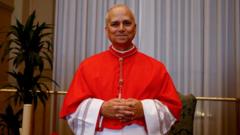The conclave to elect a new pope continues at the Vatican, marked by the emergence of black smoke from the Sistine Chapel's chimney, indicating no decision was reached after voting on the first day. With 133 cardinals participating, speculation surrounds how the new pope will respond to Pope Francis' legacy of inclusivity and reform.
Conclave Progresses: Black Smoke Signals Continued Papal Search

Conclave Progresses: Black Smoke Signals Continued Papal Search
The Vatican's conclave remains inconclusive as black smoke signals that the cardinals have yet to elect a new pope on the second day of voting.
The conclave has captured global attention as it marks the first vote for a new pope following the death of Pope Francis last month. Black smoke wafted from the chimney on Thursday morning, signaling that the cardinals’ initial voting round had concluded without a two-thirds majority for any candidate. Attendees at St. Peter’s Square expressed both anticipation and disappointment, reflecting a mixture of hope and patience.
The Cardinals will reconvene in the afternoon for additional voting rounds, planned twice each day until a consensus is reached. Historically, conclaves have varied widely in duration, with some lasting as short as a day or extending for years. As the anticipation grows, the complexities of the electoral dynamics have become apparent, especially given the diverse backgrounds of this assembly—the largest ever—and the differing factions regarding the direction of the Church.
The black smoke signal—reminiscent of a theatrical tradition—reminded observers of the ongoing deliberations and differing visions within the Church. Many anticipate more rounds of voting, with expectations rooted in the learning curves of the newer cardinals appointed by Francis. The conclave reflects a critical moment where ideological divisions, ranging from progressive to conservative perspectives, could shape the future agenda of the papacy.
As cardinals elected under Pope Francis continue to meet, the outcome will resonate not just within the Vatican, but throughout the global Catholic community. As crowds in St. Peter's Square reflect on the significance of the situation, all eyes remain fixed on the chimney, eagerly waiting for the day that white smoke signals a new beginning for the Church.
The Cardinals will reconvene in the afternoon for additional voting rounds, planned twice each day until a consensus is reached. Historically, conclaves have varied widely in duration, with some lasting as short as a day or extending for years. As the anticipation grows, the complexities of the electoral dynamics have become apparent, especially given the diverse backgrounds of this assembly—the largest ever—and the differing factions regarding the direction of the Church.
The black smoke signal—reminiscent of a theatrical tradition—reminded observers of the ongoing deliberations and differing visions within the Church. Many anticipate more rounds of voting, with expectations rooted in the learning curves of the newer cardinals appointed by Francis. The conclave reflects a critical moment where ideological divisions, ranging from progressive to conservative perspectives, could shape the future agenda of the papacy.
As cardinals elected under Pope Francis continue to meet, the outcome will resonate not just within the Vatican, but throughout the global Catholic community. As crowds in St. Peter's Square reflect on the significance of the situation, all eyes remain fixed on the chimney, eagerly waiting for the day that white smoke signals a new beginning for the Church.






















